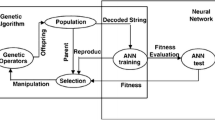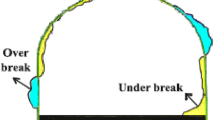Abstract
Overbreak in tunnel construction creates additional costs, and it could put the safety conditions at potential risk. This paper is aimed to predict overbreak in order to control it before drilling and blasting operations through two intelligence systems, namely, an artificial neural network (ANN) and a hybrid genetic algorithm (GA)-ANN. To achieve this aim, a database comprising of 406 datasets were prepared in the Gardaneh Rokh tunnel, Iran. In these datasets, rock mass rating (RMR), spacing, burden, special drilling, number of delays, powder factor and advance length were considered as inputs while overbreak is set as output system. Many intelligence models were created to achieve higher levels of accuracy in accordance with several performance indices, i.e., root mean square error (RMSE), variance account for (VAF) and coefficient of determination (R2). After selection of the best models, GA-ANN model results (VAF = 90.134 and 88.030, R2 = 0.903 and 0.881 and RMSE = 0.058 and 0.074 for training and testing, respectively) were better compared to ANN model results (VAF = 70.319 and 68.731, R2 = 0.703 and 0.693 and RMSE = 0.103 and 0.108 for training and testing, respectively). As a result, the GA-ANN predictive approach can be used for overbreak prediction with high performance capacity. Moreover, results of sensitivity analysis showed that overbreak is mainly influenced by the RMR parameter compared to other inputs.








Similar content being viewed by others
References
Armaghani DJ, Momeni E, Abad SVANK, Khandelwal M (2015) Feasibility of ANFIS model for prediction of ground vibrations resulting from quarry blasting. Environ Earth Sci 74:2845–2860. doi:10.1007/s12665-015-4305-y
Armaghani D, Mohamad E, Hajihassani M (2016a) Evaluation and prediction of flyrock resulting from blasting operations using empirical and computational methods. Eng Comput 32:109–121
Armaghani DJ, Faradonbeh RS, Rezaei H et al (2016b) Settlement prediction of the rock-socketed piles through a new technique based on gene expression programming. Neural Comput Appl. doi:10.1007/s00521-016-2618-8
Armaghani DJ, Mohamad ET, Narayanasamy MS et al (2017) Development of hybrid intelligent models for predicting TBM penetration rate in hard rock condition. Tunn Undergr Space Technol 63:29–43. doi:10.1016/j.tust.2016.12.009
Chambers LD (1998) Practical handbook of genetic algorithms: complex coding systems. CRC Press, Boca Raton
Chipperfield AJ, Fleming P, Pohlheim H (1994) Genetic algorithm toolbox: for use with MATLAB; User’s Guide (version 1.2). University of Sheffield, Department of Automatic Control and Systems Engineering
Dreyfus G (2005) Neural networks: methodology and applications. Springer, Berlin
Ebrahimi E, Monjezi M, Khalesi MR, Armaghani DJ (2016) Prediction and optimization of back-break and rock fragmentation using an artificial neural network and a bee colony algorithm. Bull Eng Geol Environ 75:27–36
Garrett JH (1994) Where and why artificial neural networks are applicable in civil engineering. J Comput Civil Eng 8:129–130
Ghoraba S, Monjezi M, Talebi N et al (2016) Estimation of ground vibration produced by blasting operations through intelligent and empirical models. Environ Earth Sci. doi:10.1007/s12665-016-5961-2
Goh ATC (2000) Search for critical slip circle using genetic algorithms. Civ Eng Syst 17:181–211
Goh ATC, Zhang W (2012) Reliability assessment of stability of underground rock caverns. Int J Rock Mech Min Sci 55:157–163
Haghighi M (2015) Investigation of critical parameters on overbreak in tunneling by intelligent networks. Amirkabir University of Technology, Iran
Hecht-Nielsen R (1987) Kolmogorov’s mapping neural network existence theorem. In: Proceedings of the international conference on neural networks. IEEE Press, New York, pp 11–13
Holland JH (1992) Adaptation in natural and artificial systems: an introductory analysis with applications to biology, control, and artificial intelligence. MIT press, Cambridge
Hornik K, Stinchcombe M, White H (1989) Multilayer feedforward networks are universal approximators. Neural Netw 2:359–366
Hush DR (1989) Classification with neural networks: a performance analysis. In: Proceedings of the IEEE international conference on systems engineering. pp 277–280
Ibarra JA, Maerz NH, Franklin JA (1996) Overbreak and underbreak in underground openings part 2: causes and implications. Geotech Geol Eng 14:325–340
Jahed Armaghani D, Hasanipanah M, Mahdiyar A et al (2016) Airblast prediction through a hybrid genetic algorithm-ANN model. Neural Comput Appl. doi:10.1007/s00521-016-2598-8
Jang H, Topal E (2013) Optimizing overbreak prediction based on geological parameters comparing multiple regression analysis and artificial neural network. Tunn Undergr Space Technol 38:161–169
Kaastra I, Boyd M (1996) Designing a neural network for forecasting financial and economic time series. Neurocomputing 10:215–236
Kanellopoulos I, Wilkinson GG (1997) Strategies and best practice for neural network image classification. Int J Remote Sens 18:711–725
Khandelwal M, Armaghani DJ (2016) Prediction of drillability of rocks with strength properties using a hybrid GA-ANN technique. Geotech Geol Eng 34:605–620. doi:10.1007/s10706-015-9970-9
Khandelwal M, Monjezi M (2013) Prediction of backbreak in open-pit blasting operations using the machine learning method. Rock Mech Rock Eng 46:389–396
Lee Y, Oh S-H, Kim MW (1991) The effect of initial weights on premature saturation in back-propagation learning. In: Neural Networks, 1991, IJCNN-91-Seattle international joint conference on. IEEE, pp 765–770
Majdi A, Beiki M (2010) Evolving neural network using a genetic algorithm for predicting the deformation modulus of rock masses. Int J Rock Mech Min Sci 47:246–253
Masters T (1993) Practical neural network recipes in C++. Morgan Kaufmann, Burlington
Mohamad ET, Faradonbeh RS, Armaghani DJ et al. (2016) An optimized ANN model based on genetic algorithm for predicting ripping production. Neural Comput Appl 1–14. doi:10.1007/s00521-016-2359-8
Momeni E, Nazir R, Armaghani DJ, Maizir H (2014) Prediction of pile bearing capacity using a hybrid genetic algorithm-based ANN. Measurement 57:122–131
Monjezi M, Dehghani H (2008) Evaluation of effect of blasting pattern parameters on back break using neural networks. Int J Rock Mech Min Sci 45:1446–1453
Monjezi M, Khoshalan HA, Varjani AY (2012) Prediction of flyrock and backbreak in open pit blasting operation: a neuro-genetic approach. Arab J Geosci 5:441–448
Monjezi M, Ahmadi Z, Varjani AY, Khandelwal M (2013) Backbreak prediction in the Chadormalu iron mine using artificial neural network. Neural Comput Appl 23:1101–1107
Monjezi M, Rizi SMH, Majd VJ, Khandelwal M (2014) Artificial neural network as a tool for backbreak prediction. Geotech Geol Eng 32:21–30
Paola JD (1994) Neural network classification of multispectral imagery. M.Sc. thesis, The University of Arizona, USA
Ripley BD (1993) Statistical aspects of neural networks. Netw Chaos Stat probab Asp 50:40–123
Saemi M, Ahmadi M, Varjani AY (2007) Design of neural networks using genetic algorithm for the permeability estimation of the reservoir. J Pet Sci Eng 59:97–105
Saghatforoush A, Monjezi M, Faradonbeh RS, Armaghani DJ (2016) Combination of neural network and ant colony optimization algorithms for prediction and optimization of flyrock and back-break induced by blasting. Eng Comput 32:255–266
Simpson PK (1990) Artificial neural systems: foundation, paradigms, applications and implementations. Pergamon, New York
Singh TN, Verma AK (2012) Comparative analysis of intelligent algorithms to correlate strength and petrographic properties of some schistose rocks. Eng Comput 28:1–12
Singh SP, Xavier P (2005) Causes, impact and control of overbreak in underground excavations. Tunn Undergr Space Technol 20:63–71
Singh J, Verma AK, Banka H et al (2016) A study of soft computing models for prediction of longitudinal wave velocity. Arab J Geosci 9:1–11
Swingler K (1996) Applying neural networks: a practical guide. Academic Press, New York
Tonnizam Mohamad E, Hajihassani M, Jahed Armaghani D, Marto A (2012) Simulation of blasting-induced air overpressure by means of artificial neural networks. Int Rev Model Simul 5(6):2501–2506
Verma AK, Singh TN (2013) A neuro-fuzzy approach for prediction of longitudinal wave velocity. Neural Comput Appl 22:1685–1693
Wang C (1994) A theory of generalization in learning machines with neural applications. Ph.D. thesis, The University of Pennsylvania, USA
Wang X, Tang Z, Tamura H et al (2004) An improved backpropagation algorithm to avoid the local minima problem. Neurocomputing 56:455–460
Zhang W, Goh ATC (2016) Multivariate adaptive regression splines and neural network models for prediction of pile drivability. Geosci Front 7:45–52
Zhu W (2004) Stability analysis and modelling of underground excavations in fractured rocks. Elsevier Geo-Engineering Book Series. Elsevier Science and Technology, Amsterdam
Zorlu K, Gokceoglu C, Ocakoglu F et al (2008) Prediction of uniaxial compressive strength of sandstones using petrography-based models. Eng Geol 96:141–158
Author information
Authors and Affiliations
Corresponding author
Rights and permissions
About this article
Cite this article
Koopialipoor, M., Jahed Armaghani, D., Haghighi, M. et al. A neuro-genetic predictive model to approximate overbreak induced by drilling and blasting operation in tunnels. Bull Eng Geol Environ 78, 981–990 (2019). https://doi.org/10.1007/s10064-017-1116-2
Received:
Accepted:
Published:
Issue Date:
DOI: https://doi.org/10.1007/s10064-017-1116-2




